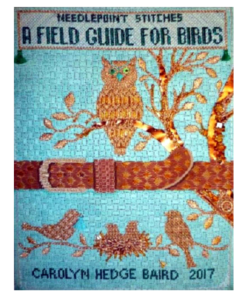
Carolyn Hedge Baird, self-published, 2017, $60
While we needlepoint many things, birds are one of the trickiest. Besides the usual problems of different sizes, they face different ways, come in tons of colors and shapes and have nagging details such as feathers, legs, and beaks. This could be one reason why a large canvas with five birds on it that I love languishes in my UFO pile. Finding stitches for all that is just too hard!
Carolyn’s newest book is the answer to the prayers of perplexed bird stitchers everywhere. She loves birds and has stitched or written stitch guides for many. This means she’s put lots of thought into how to stitch birds effectively.
Her book starts with an introduction helping you understand the birds you’ll find on canvas and how this affects stitch direction. Because birds’ feathers grow in one direction, the stitch needs to reflect this. You do this by changing stitch direction. Using a small leaf stitch as an example, she shows us how to change direction to male it effective for birds seen from either side as well as from front or back.
This thorough approach goes throughout the book. Stitch diagrams are accompanied by bird silhouettes that tell us what type of bird can use it. If the bird on your canvas doesn’t match the silhouette, find a different stitch, which may be close by.
After the introduction come the stitches, in chapters, by the size of the bird: tiny, small, medium, and large. Stitches in the tiny chapter are mostly taken from her previous book on tiny stitches, but with the addition of notes and the silhouettes it’s easier to apply these stitches. The other chapters present more stitches with similarly helpful information.
Often the notes tell you where on the bird the stitch can be used best. I like that because it’s so helpful in planning a canvas. To give you an idea of how this works, each chapter begins with a page with pictures of two birds with stitch suggestions for each.
The one fault I see in these chapters is that we don’t really know what size constitutes “small,” “medium,” and “large.” We are told tiny birds are under 1/2″. I wish we knew that information for all the chapters. Thinking about my canvas, are my 3″ birds small or medium? Where should I look for stitches?
As is always the case with Carolyn’s books you will not find fancy professional diagrams here. Though not hand-drawn, they have that quality. Even so, they are very easy to understand.
The last chapter covers bird details such as eyes, combs, and legs. But it also expands the details to eggs and nests, both of which you’ll find often on canvases of this type. I liked these, especially the idea for incorporating found objects into nest stitching.
I do wish though she had included more ideas for stitching the fancy tails of roosters. I think here is one place where creative ideas would be welcome.
One caution though, several of the stitches in the book are complex. If you are a beginner or unsure of a stitch, practice it on a doodle cloth first.
The book ends with a lengthy index of stitches, plus two smaller indexes of stitches for backgrounds and stitches where beads can be added. At just over 300 pages, this book is a fantastic resource. It’s got me fired up about my birds!
About Janet M Perry
Janet Perry is the Internet's leading authority on needlepoint. She designs, teaches and writes, getting raves from her fans for her innovative techniques, extensive knowledge and generous teaching style. A leading writer of stitch guides, she blogs here and lives on an island in the northeast corner of the SF Bay with her family

Sounds like a great reference! Are there similar reference books for fur and hair on animals?
Not that I know of. There are books on hairdos and on ideas for beards, but not on animal fur.
Keep stitching,
Janet